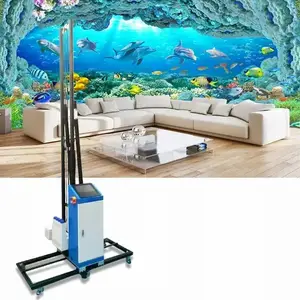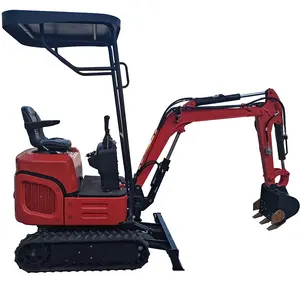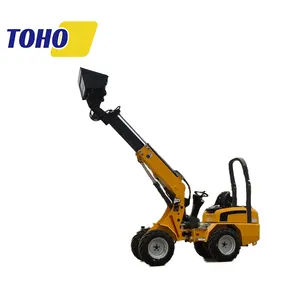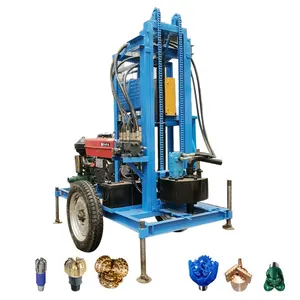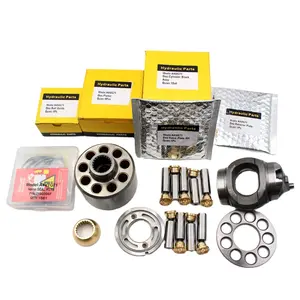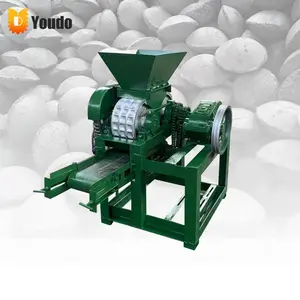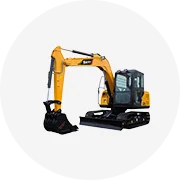Popular en tu industria






Mini Excavadora hidráulica pequeña, 0,8 toneladas, 1 tonelada, 2 toneladas, 3 toneladas, 6 toneladas, precio de fábrica
EUR 1,946.66 - EUR 2,966.33
Pedido mínimo: 1 pieza






Piezas de tren de rodaje piñón de pista de goma rodillo inferior superior grupo de pista de acero para Kubota U K KX KH serie Mini excavadora
EUR 35.23 - EUR 111.24
Pedido mínimo: 1 pieza







Mini excavadora rodillo inferior kx101 3 rodillos de pista para Kubota
EUR 9.27 - EUR 14.84
Pedido mínimo: 1 pieza







Piezas de tren de rodaje de miniexcavadora, Piñón de pista de goma, conjunto de rodillo inferior superior para Kubota Hitachi Kobelco Volvo
EUR 35.23 - EUR 82.51
Pedido mínimo: 1 pieza







Omatsu-excavadora de centro comercial modelo C01, máquina de excavación usada de 1 año
EUR 5,376.48 - EUR 7,415.83
Pedido mínimo: 1 pieza







Piezas de repuesto de pistón hidráulico para excavadora, Kits de reparación de bomba de Motor oscilante para REXROTH, venta al por mayor, Kawasaki
EUR 26.89 - EUR 101.05
Pedido mínimo: 1 pieza


Mini excavadora K008-3, rodillos de pista para Piezas de chasis, piezas de maquinaria de construcción
EUR 27.81 - EUR 46.35
Pedido mínimo: 12 piezas






Mini excavadora de alta calidad Kubota U30/135 cilindro de tensión piezas de maquinaria de construcción cilindro de tensión KX30
EUR 52.84 - EUR 60.26
Pedido mínimo: 1 pieza




Piezas de excavadora KUBOTA rx302, dispositivo de conducción final, motor de viaje para mini excavadora RX301 RX501, novedad
Listo para enviar
EUR 1,066.03
Pedido mínimo: 1 pieza
Envío por pieza: EUR 352.21






KUBOTA-mini excavadoras KX040 KH040, piezas de repuesto para chasis delantero
EUR 97.34 - EUR 106.61
Pedido mínimo: 2 piezas






Excavadora Original Nuevo Kubota V3300 Motor 37-75KW 2200RPM Piezas de excavadora Ensamblaje de motor 1G376-18000
EUR 3,012.68 - EUR 3,615.22
Pedido mínimo: 1 pieza
Búsquedas Relacionadas:
excavadora compacta kubotarefrigeración de ventilador para excavadora hyundaimini excavadora kubotapista de goma para la mini excavadora kubotasinfín para mini excavadora kubotamini excavadora de piezas komatsuproveedor de excavadora kubotamini excavadora kabotamini excavadora yanmarnuevos precios de excavadora kubotamini excavadora kubota precionueva mini excavadora kubota precioventa de excavadoras kubota usadasventa excavadora kubotanueva excavadora kubota




Kubota-miniexcavadora u35 u55 de 2,5-4,5 toneladas, accesorios de segunda mano, piezas de repuesto, martillo hidráulico para excavadora
EUR 926.98 - EUR 27,809.34
Pedido mínimo: 1 conjunto






Mini excavadora KX22, piezas compactas, rodillo superior
EUR 26.89 - EUR 36.16
Pedido mínimo: 30 piezas






Kubota-miniexcavadora Kh70, montaje de riel de K008-3, Kh15, Kh60
EUR 60.26 - EUR 69.53
Pedido mínimo: 2 piezas




El condensador de acondicionamiento de piezas de mini excavadora es la excavadora Kubota U35N
EUR 41.72 - EUR 78.80
Pedido mínimo: 1 conjunto



KH70-Mini excavadora con cadena de eslabones, piezas para Kubota
EUR 278.10 - EUR 741.59
Pedido mínimo: 2 piezas






Kubota Miniexcavadoras KX040 KH040 Piezas de repuesto del tren de rodaje delantero
EUR 46.35 - EUR 277.17
Pedido mínimo: 1 pieza
Envío por pieza: EUR 398.99






Piezas de repuesto de pista de tren de rodaje Mini Excavadora Kx91 Rodillo portador superior para excavadora Kubota
EUR 18.54 - EUR 27.81
Pedido mínimo: 2 piezas





Belparts-piezas de Mini excavadora Kubota kx41, motor de accionamiento oscilante u45 para KX41-2 de excavadora
EUR 1,073.45 - EUR 1,119.79
Pedido mínimo: 1 pieza
Envío por pieza: EUR 379.06






Kubota-miniexcavadora, Piñón kx91 para excavadora kubota
Listo para enviar
EUR 25.96 - EUR 36.16
Pedido mínimo: 1 pieza
Envío por pieza: EUR 47.48






Fabricante oficial Excavadora XE75U 7.5Ton Mini Excavadora con motor Kubota 0.3Cbm Capacidad de cubo
EUR 43,846.06 - EUR 47,924.77
Pedido mínimo: 1 unidad
Envío por pieza: EUR 25,028.41






Mini excavadoras, conjunto de rueda loca Kubota, guía de rueda loca delantera, piezas de repuesto de tren de rodaje, 2, 1, 2, 1, 2, 2, 1, 2
EUR 74.16 - EUR 97.34
Pedido mínimo: 2 piezas
Envío por pieza: EUR 197.85



Kit de reconstrucción D902 para Mini excavadora Kubota RTV900 D902 D902-E, piezas de repuesto para motor de D902-ET02
Listo para enviar
EUR 398.61
Pedido mínimo: 1 conjunto
Envío por pieza: EUR 34.36






2024 accesorios para la venta rastrillo de excavadora piezas de repuesto Venta De fábrica rastrillo de excavadora para 0,8 ton/1 ton/1,2 Ton mini excavadora
Listo para enviar
EUR 83.43 - EUR 92.70
Pedido mínimo: 1 pieza
Envío por pieza: EUR 412.18






Pieza de repuesto mini excavadora Kubota excavadora sh60 piezas
EUR 25.96 - EUR 63.04
Pedido mínimo: 1 pieza
Envío por pieza: EUR 43.99


Piezas de excavadora KX161 bomba principal hidráulica para excavadoras Kubota
EUR 2,206.21 - EUR 2,475.04
Pedido mínimo: 1 pieza






Las mejores piezas de excavadora OEM, rodillo portador de rodillos superior e inferior para miniexcavadora Volvo y Kubota
EUR 22.25 - EUR 27.81
Pedido mínimo: 1 pieza






Mini excavadora u15 u17, motor oscilante 2-200d0s-e3, u15-2, piezas kubota, u15-3
EUR 926.98 - EUR 1,390.47
Pedido mínimo: 1 pieza






Miniexcavadora KX91, piezas de repuesto de pista de tren de rodaje de, rodillo portador superior para excavadora Kubota
Listo para enviar
EUR 34.30 - EUR 37.08
Pedido mínimo: 2 piezas
Envío por pieza: EUR 46,348.90






Piezas de excavadora mini excavadora KX61 KX21 transmisión final para Kubota
EUR 248.44 - EUR 526.53
Pedido mínimo: 1 pieza




Bomba hidráulica para Kubota u30 u35 vio30 vio35 mini excavadora piezas de bomba de psvd2-13e
EUR 509.84 - EUR 787.94
Pedido mínimo: 1 pieza






Kit de reconstrucción de reacondicionamiento D902 para miniexcavadora Kubota RTV900 D902, piezas de repuesto de motor de 21/2 ", piezas de repuesto para motor de 1/2"
EUR 60.26 - EUR 64.89
Pedido mínimo: 1 pieza






Piezas del tren de rodaje del piñón de La miniexcavadora Kubota de
EUR 53.77 - EUR 55.62
Pedido mínimo: 5 piezas






Natural de la pista de goma de 485*92*74 para Kubota Mini excavadora construcción pista de goma para Dumper... pavimentadora ect
EUR 185.40 - EUR 1,112.38
Pedido mínimo: 1 pieza






Piezas de Mini excavadora de accionamiento Final, Motor de viaje para Kubota Takeuchi Sumitomo IHI Caterpillar Komatsu Hyundai
Listo para enviar
EUR 92.70 - EUR 185.40
Pedido mínimo: 1 pieza
Envío por pieza: EUR 264.19






Precio barato, buena calidad, motor rotativo hidráulico Kubota, Kubota miniexcavadora, motor oscilante de 2, 2, 2, 3, 2, 2, 2, 2, 2, 2, 2, 2, 2, 2
EUR 463.49 - EUR 537.65
Pedido mínimo: 1 pieza






Belparts-piezas de excavadora TM02 PHV-1B, MAG-12V de motor de viaje, U15-3 PC14R2 CX18, accionamiento final para kubota U15
EUR 626.64
Pedido mínimo: 1 pieza






Motor final de viaje YOONGSHING para Doosan para Daewoo para funda para Kubota para Takeuchi para Kato mini pequeña excavadora grande
EUR 83.43 - EUR 92.70
Pedido mínimo: 1 pieza
Envío por pieza: EUR 379.06






Mini excavadora piezas E20 E17 E19 Motor oscilante 104-6457-005 Kubota U20 U25 Motor de dispositivo rotativo
EUR 630.35 - EUR 760.13
Pedido mínimo: 1 pieza
Categorías principales
Sobre piezas kubota mini excavadora
Alibaba.com ofrece los productos 9638 piezas kubota mini excavadora. Una amplia variedad de opciones de piezas kubota mini excavadora está disponibles para usted, como por ejemplo obras de construcción, reparación de maquinaria tiendas y construcción. También puede elegir de francia, los estados unidos y italia piezas kubota mini excavadora, así como de motor, motor y de la bomba piezas kubota mini excavadora.Y si piezas kubota mini excavadora es 1ton, 1.5ton o 1.8ton.
